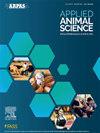Review: Sustainable phosphorus use in the United States beef cow-calf industry—Requirements, forage, soil, and water content, supplementation, and nutritional recommendations for producers
IF 1.5
Q3 AGRICULTURE, DAIRY & ANIMAL SCIENCE
引用次数: 0
Abstract
Purpose
The objective is to explain the current understanding of the biological importance of P to beef cattle congruent with current established requirements as well as describe the current management toward P supplementation, nutritional recommendations, quantify forage, soil, and water mineral concentrations, and identify existing knowledge gaps specific for improving sustainable use of the mineral in United States cow-calf production.
Sources
Peer-reviewed literature, abstracts, experiment station progress reports, technical bulletins, and reports were the primary sources of information reviewed.
Synthesis
Phosphorus is essential for beef cattle productivity and health as well as a potential water contaminant. Although efforts have been made in recent years to improve our understanding of requirements for growing and finishing beef cattle, relatively little work has been done focused on the cow-calf segment of the industry. Because grazing beef cattle frequently use surface water sources, producers play a critical role in minimizing P introduction to waters. Soil and forage P levels and responses to supplementation vary widely and studies including both animal and agronomic components of P utilization are very limited. Concurrently, data directly evaluating the effect of specific best management practices for improving sustainable P use within cow-calf production systems on surface water quality are few and would be beneficial for industry guidance and producer adoption.
Conclusions and Applications
Long-term cow-calf studies reporting intake and production outcomes that also include soil and forage P levels are needed for developing industry benchmarks and accurate supplementation recommendations. Best management practices implemented holistically are key for minimizing the industry’s use of supplemental P while optimizing animal health and production, particularly in areas where public water quality is of concern.
综述:美国肉牛-小牛工业中磷的可持续利用——要求、饲料、土壤和水分含量、补充和对生产者的营养建议
目的:目的是解释目前对磷对肉牛的生物学重要性的理解,符合目前既定的要求,并描述目前对磷补充的管理,营养建议,量化饲料,土壤和水中矿物质浓度,并确定现有的知识差距,具体到改善美国小牛生产中矿物质的可持续利用。来源同行评议的文献、摘要、实验站进展报告、技术公告和报告是所审查信息的主要来源。磷对肉牛的生产和健康至关重要,也是一种潜在的水污染物。尽管近年来已经做出了努力,以提高我们对肉牛生长和育肥要求的理解,但在该行业的牛犊牛部分所做的工作相对较少。由于放牧肉牛经常使用地表水,因此生产者在尽量减少向水体引入磷方面发挥着关键作用。土壤和饲料磷水平及其对磷补充的响应差异很大,包括动物和农艺成分的磷利用研究非常有限。同时,直接评价具体最佳管理做法对改善牛-小牛生产系统内可持续磷利用对地表水质量影响的数据很少,这将有利于行业指导和生产者采用。结论和应用报告摄入和生产结果的长期犊牛研究,包括土壤和饲料磷水平,需要制定行业基准和准确的补充建议。全面实施最佳管理实践是最大限度地减少行业补充磷使用,同时优化动物健康和生产的关键,特别是在公共水质受关注的地区。
本文章由计算机程序翻译,如有差异,请以英文原文为准。
求助全文
约1分钟内获得全文
求助全文

 求助内容:
求助内容: 应助结果提醒方式:
应助结果提醒方式:


